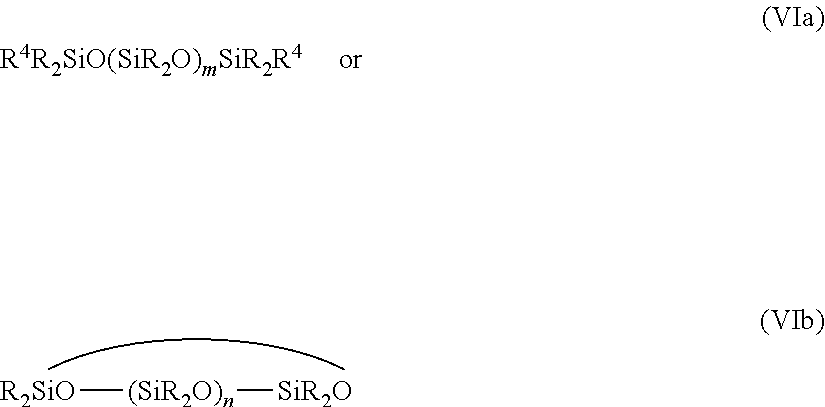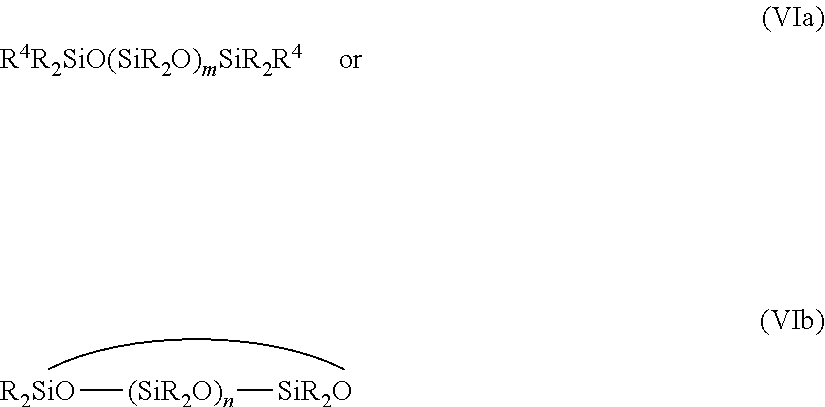Defoaming formulations containing organopolysiloxanes
- Summary
- Abstract
- Description
- Claims
- Application Information
AI Technical Summary
Benefits of technology
Problems solved by technology
Method used
Image
Examples
examples 1
Production of the Organosilicon Compounds (A):
a) Organosilicon Compound A1:
[0217]In a 500 mL three-necked flask 101.0 g of an equilibrate of dimethylsiloxy and vinyldimethylsiloxy units having an iodine number of 22.0 with 2.7 g of a hydrolyzate of hydrogenmethyldichlorosilane terminated with trimethylsiloxy units and having a chain length of about 55 Si units, 120.0 g of an OH-terminated polydimethylsiloxane having a viscosity of 62 mm2 / s (25.0° C.; capillary no. II) and 28.6 g of an equilibrate of dimethylsiloxy and trimethylsiloxane units having a viscosity of 35 mm2 / s (25.0° C.; capillary no. II) are equilibrated for two hours with 250 ppm of PNCl2 at 120° C. and a reduced pressure of 20 mbar. The catalyst is deactivated by addition of NaHCO3. After filtration and removal of volatile constituents at 160° C. and a reduced pressure of 40 mbar a polysiloxane A1 having a viscosity of 81 mm2 / s (25.0° C.; capillary no. II), an iodine number of 13.3 and an H content of 0.016% by weight...
examples 2
Production of the Organopolysiloxanes (1):
a) Organopolysiloxane (1-1):
[0221]In a 250 ml three-necked flask 100.0 g of the polysiloxane A1 dissolved in 50 ml of xylene together with 0.2 g of a toluenic solution of Karstedt's Pt catalyst (Pt content: 0.3% by weight) is heated to 90° C. for 3.5 h. During the final cooling 0.3 g of diallyl maleate are added. Xylene is removed at 90° C. and under a reduced pressure of 32 mbar. A polysiloxane (1-1) having a viscosity of 425 mPas (measured at 25° C. and a shear rate of 1 l / s) is obtained.
[0222]Production of organopolysiloxane (1-1) thus employs exclusively polysiloxane A1 and the predominant component is therefore structural element (IV) where x=52. (1-1) is in the form of a flowable compound not inclined to gelling. It is thus not necessary to use an inert solvent.
b) Organopolysiloxane (1-2):
[0223]In a 250 mL three-necked flask 100.0 g of the polysiloxane A2 together with 55.0 g of a linear vinyldimethylsilyl-terminated polydimethylsiloxa...
examples 3
Production of the Inventive Defoamer Formulations C1-C4 Comprising the Organopolysiloxanes(1) and Production of the Noninventive Defoamer Formulations VC5-VC9:
[0235]To produce the defoamer formulations the substances described in table 1 are mixed with a dissolver and heated to 150° C. for 4 hours in the presence of 1500 ppm of KOH (20% solution in methanol) and, after cooling, re-homogenized with the dissolver.
TABLE 1Composition of the defoamer formulationsCompo-Compo-Compo-Compo-Compo-nentsnent (1)nent (2)nent (3)nent (4)(5) / (6)Ex. / Comp.PartsPartsPartsPartsPartsC174.35.04.016.00.7(1-1)D1E1F1G1C274.35.04.016.00.7(1-2)D1E1F1G1C374.35.04.016.00.7(1-3)D1E1F1G1C474.35.04.016.00.7(1-2)D1E1F1G14.0G2VC574.35.04.016.00.7((noninventive)V(1-4)D1E1F1G1VC6 1)74.35.04.016.00.7(noninventive)V2aD1E1F1G1VC7 2)82.44.94.9 7.40.4(noninventive)V2bD1E1F1G1VC8 3)—5.04.016.00.7(noninventive)D1E1F1G164.3F210.0F3VC9 4)82.44.94.9 7.40.4(noninventive)V2cD1E1F1G11) Comparative test VC6 according to EP 516 109...
PUM
| Property | Measurement | Unit |
|---|---|---|
| Temperature | aaaaa | aaaaa |
| Fraction | aaaaa | aaaaa |
| Pressure | aaaaa | aaaaa |
Abstract
Description
Claims
Application Information
 Login to View More
Login to View More - R&D
- Intellectual Property
- Life Sciences
- Materials
- Tech Scout
- Unparalleled Data Quality
- Higher Quality Content
- 60% Fewer Hallucinations
Browse by: Latest US Patents, China's latest patents, Technical Efficacy Thesaurus, Application Domain, Technology Topic, Popular Technical Reports.
© 2025 PatSnap. All rights reserved.Legal|Privacy policy|Modern Slavery Act Transparency Statement|Sitemap|About US| Contact US: help@patsnap.com


